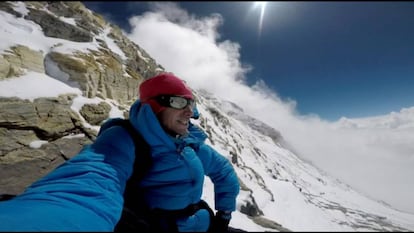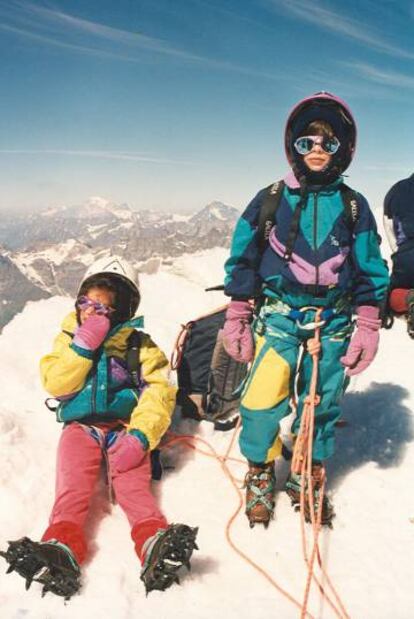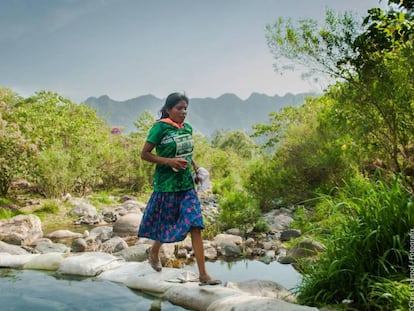Kilian Jornet: the Spanish ‘superman’ who climbed Everest twice in six days
Raised in Catalan mountains, former champion ultramarathon runner has been described as a machine
Kilian Jornet hates cities. Among cars and people he feels like an outsider in a strange world. Dani Brotons, the doctor who keeps a watch on the health of the Catalan ultra-marathon runner and mountaineer only manages to get him to get as close as the Hospital de Cerdaña near the Spanish-French border for his annual checkup.

That’s where – among cables and sensors – screens show the data belonging to a “superman” capable of climbing Mount Everest in six days, a feat Jornet carried out recently without supplemental oxygen or fixed ropes. Only a handful of Sherpas have managed to reach the summit of the 8,848-meter-high mountain in less than a week.
The Spanish climber can breathe up to 200 liters of oxygen a minute when exercising
Jornet completed the first climb in 26 hours, beginning his ascent at the Rongbuk Monastery (5,100 meters), climbing more than 3.7 kilometers up in just over a day before descending for 12 hours to the advanced based camp, at 6,500 meters. As if that weren’t remarkable enough, a stomach bug meant that the climb was slower than he had anticipated. Without making his plans public, the 29-year-old completed another ascent from the advanced base camp and reached the summit in 17 hours – four-and-a-half hours faster than his previous attempt and close to the record of the Italian Hans Kammerlander in 1996, who clocked up a time of 16 hours and 45 minutes. Jornet’s descent was also half-an-hour faster than he had managed a few days earlier.
What sort of body is capable of something like this? The report put together by the doctor of the climber who is 1.72 meters tall and weighs 59 kilos reveals some exceptional details: he has a maximum oxygen intake of up to 89 milliliters per kilogram per minute – around the same level as British cyclist Chris Froome and Spanish cycling legend Miguel Indurain, both with a measurement of 88.

By contrast, most people Jornet’s age who regularly practice sport have an intake of around 50 milliliters per kilogram, a figure that halves above an altitude of 5,500 meters.
The Spanish climber can also breathe up to 200 liters of oxygen a minute when exercising and eliminates a great deal of carbon dioxide. The final piece of the puzzle is his body’s ability to deal with the build-up of lactic acid in muscles, which causes pain. After high levels of exertion, Jornet’s body is ready to perform again. The combination of these three factors – oxygen uptake, amount of air breathed and recovery ability – are what make Jornet’s body a machine.
“But there is something that brings all of this to its maximum potential: his mind,” says Brotons, who has worked with Spanish Winter Olympics teams.
“He has phenomenal mental power because he likes what he does, he doesn’t feel as if he is suffering. With all of these elements coming together, Kilian can do what he wants. He doesn’t know where his limits are.”
Both genetics and the surroundings he grew up in have shaped Jornet. His father, a mountain hut watchman, and his mother, a teacher of mountain sports, put him on skis before he could walk. The family lived at the Cap de Rec mountain hut in the Pyrenees in Spain’s Lleida province, at 2,000 meters, and with a ski resort close by. Jornet climbed his first 3,000-meter mountain at age three, at seven he climbed his first 4,000-er, and aged 10 he completed a traverse of the Pyrenees.
Jornet became the best ultramarathon runner in the world, smashing race records
“As children we were outside all day in the forest or on the slopes,” his sister Naila recalls. “And Kilian was a beast, running all day.”
Jornet later became the best ultramarathon runner in the world, smashing records in races including the Ultra-Trail du Mont-Blanc, Grand Raid (on the French island of Réunion), and the Western States Endurance Run in California.
The move from running to climbing 8,000-meter peaks was not straightforward. Mountaineer Jordi Tosas, a friend of Jornet, introduced the Spaniard to the challenge of speed climbing in the mountains by leading him on trips to Alaska and the European Alps.
“Kilian was born in the mountains. He is a strong athlete and a natural on the mountains, and he is learning the technical aspects of climbing,” says Tosas, noting that Jornet is not at the level of Swiss climber Ueli Steck, who died in April while preparing to climb the Hornbein route on the West Ridge of Everest.
“Kilian is not at that level. He is getting to know the big mountains and has to decide if he wants to continue running of them, or climbing them. They are two different worlds,” Tosas concludes.
Jornet is incredibly fast in the mountains and in the Pyrenees can climb 1,000 vertical meters in 40 minutes. Even at altitudes of between 7,000 and 8,000 meters, he can climb 330 meters an hour. Steck managed 350 meters, while some Sherpas can manage as much as 450 meters an hour.
English version by George Mills.
Tu suscripción se está usando en otro dispositivo
¿Quieres añadir otro usuario a tu suscripción?
Si continúas leyendo en este dispositivo, no se podrá leer en el otro.
FlechaTu suscripción se está usando en otro dispositivo y solo puedes acceder a EL PAÍS desde un dispositivo a la vez.
Si quieres compartir tu cuenta, cambia tu suscripción a la modalidad Premium, así podrás añadir otro usuario. Cada uno accederá con su propia cuenta de email, lo que os permitirá personalizar vuestra experiencia en EL PAÍS.
¿Tienes una suscripción de empresa? Accede aquí para contratar más cuentas.
En el caso de no saber quién está usando tu cuenta, te recomendamos cambiar tu contraseña aquí.
Si decides continuar compartiendo tu cuenta, este mensaje se mostrará en tu dispositivo y en el de la otra persona que está usando tu cuenta de forma indefinida, afectando a tu experiencia de lectura. Puedes consultar aquí los términos y condiciones de la suscripción digital.
More information
Archived In
Últimas noticias
Maduro pleads not guilty before the federal court in New York: ‘I am still the president of Venezuela’
A new test can detect Alzheimer’s from a finger prick
UN team enters Sudanese city of El Fasher after paramilitary massacre: ‘It’s like a ghost town’
A recipe for resistance: Indigenous peoples politicize their struggles from the kitchen
Most viewed
- Gilles Lipovetsky: ‘If you want to live better and fall in love, take Prozac, don’t look to philosophy’
- Alain Aspect, Nobel laureate in physics: ‘Einstein was so smart that he would have had to recognize quantum entanglement’
- Maduro’s downfall puts China’s relationship with Venezuela to the test
- Why oil has been at the center of Venezuela-US conflicts for decades
- Alvin Hellerstein, a 92-year-old judge appointed by Bill Clinton, to preside over Maduro’s trial in New York











































